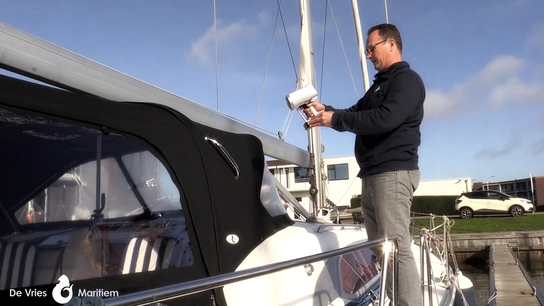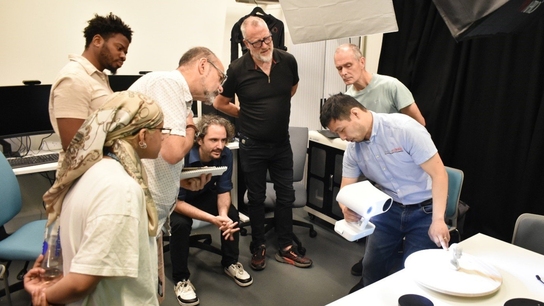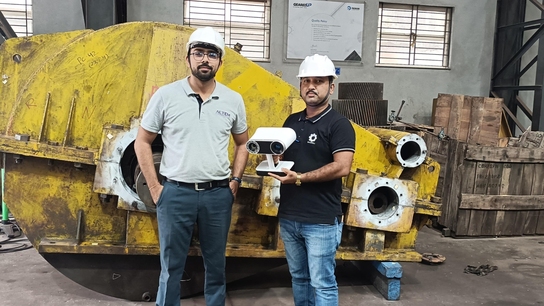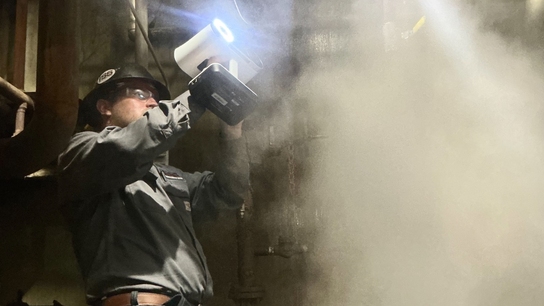3D technology meets artistic locksmithing: using Artec Space Spider for bronze work design and reproduction
Challenge: Rémy Garnier needed an alternative for a measuring arm that would allow for highly precise 3D capture of bronze creations, while both preserving their beauty and modernizing the company’s two-century technique.
Solutions: Artec Space Spider, Artec Studio
Result: The company’s oeuvre of the unique bronze and brass work, from handles and knobs to luminaries to decorative grills, has been digitized for archiving, restoration, prototyping, and reverse engineering.
Why Artec? Artec 3D technology allows artisans across the globe to capture the most intricate physical forms with exceptional accuracy, which makes an easy integration of traditional craftsmanship and cutting-edge digital design entirely possible, while opening up endless possibilities for enhancing the creative process.

Imagine walking through a classically beautiful Parisian room exuding opulence and grandeur – perhaps in a museum, a palace, or a hotel. Look at the elaborate chandelier hanging from the gilded ceiling, over to the chiseled light fixtures adorning the walls, and, finally, place your hand on an elegant door handle. There’s a high chance that at least some of these are the work of Rémy Garnier.
Two centuries of instilling inspiration through artisanal bronze work
Whether it’s the Eiffel Tower, the Louvre Museum, the Ritz Paris, or any of the hundreds more of exceptional locations including historical monuments in France and abroad, the renowned bronze maker has had a hand in their interior design or restoration. Founded in 1831, Rémy Garnier House has been a reference in artistic locksmithing ever since. Throughout its history, the company has stayed true to its traditional craftsmanship while integrating contributions from various talents.
Gradually, it developed into an interior restoration expert, as well as a specialized historical workshop offering two product lines and a catalog collection with more than 8,000 references, including espagnolettes, locks, handles, knobs, lighting fixtures, and luminaires. Some of the models in the catalog can rightfully be referred to as artisan heritage, such as the famous “crémones,” the invention of Rémy Garnier himself. It was only natural that at some point the teams at the House felt the need for a newer, more innovative approach to their archiving, design, and reproduction processes.

Crémones bolt, the signature intention by Rémy Garnier, came to replace most locks and espagnolettes in modern luxury buildings.
Preserving their almost bicentennial expertise in modern times would be impossible without the fusion of traditional knowledge and next-generation technology, which was why Rémy Garnier considered 3D technology in the first place. To hone their own craftsmanship, modernize workflows, and archive collections, the company turned to 3D NUM, an Artec 3D ambassador known for enabling businesses to bring their ideas to life through advanced additive manufacturing processes.
Speed and precision for rediscovering the craftsmanship heritage secrets
After an initial meeting back in 2016, the company decided to replace their measuring arm, known for its accuracy but also – unfortunately – for generating excessively large files. As an alternative, Rémy Garnier embraced the portable 3D scanner Artec Space Spider, a recommendation by 3D NUM. To ensure proficiency with Artec 3D technology, 3D NUM arranged a live demo and a comprehensive hands-on training session, which brought the team to full terms with the various uses and functionalities of the scanner, leading to immediate scanning efficiency.

The House’s artistic heritage can be found in the catalog with more than 8000 entries.
The scanner went on to address multiple needs at once. Since Rémy Garnier relies on lost-wax casting or sand casting techniques to manufacture its luxury pieces, a significant challenge was to ensure the longevity and precision of the initial, parent models. This involved extracting knowledge about these pieces, particularly through reverse engineering to determine exact surface details, such as estimating gold plating needs. Another part of the challenge was linked to the fact that, in the fiercely competitive luxury industry, creating 3D models promptly becomes crucial to maintaining a balance between excellence and edge, especially within the realm of bronze craftsmanship.

Artec Space Spider’s ability to render the finest geometry is perfect for ornate objects with decorative details.
Both demands – precision and speed – were instantly satisfied. Known for its unparalleled accuracy and ability to capture intricate details of small objects, Space Spider was just right for capturing the delicate features of the artisan designs. The non-contact scanning ensured that the treasured bronze creations remained undisturbed, while the time required to scan multiple artifacts or large collections was reduced to an impressive minimum. All this was entirely consistent with the hopes and intentions of the company.
The technology to take the unique know-how to a new level
The entire process was now reduced to several simple steps – preparing the object if necessary (spraying it lightly in case of the granularity and finesse of the material), capturing the 3D data off the object, and importing the quick and crispy scans into Artec Studio for processing. From there, the model can be quickly and seamlessly integrated into Geomagic Wrap for specialized refinements and SolidWorks for layout creation and surface extraction. Some impressive examples of easy scanning include the “crémone,” an emblematic symbol of the House: creating the entire 3D model now takes four hours, including the surface processing in the software. For creating a digital twin of a signature decorated door handle, Rémy Garnier’s design department now allocates one hour.

After seamless processing in Artec Studio, the models can be easily integrated into specialized software.
“Rémy Garnier has always embraced the challenges related to technology adoption in our craft, whether to simplify artisans’ work or improve efficiency,” said Adrien Couradette, Workshop Manager and 3D Designer at Rémy Garnier.
The difference made by 3D technology is astonishing: any long and tedious work, whether for preserving the company’s heritage, restoring national monuments, catering to individual needs of the House’s customers, or fostering business development, was made easy with 3D scanning, eventually turning into a perfect blend of tradition and innovation. According to the team, what used to take several days in documentation or reverse engineering workflows, could now be done in just a few hours. Notably, the time needed to prototype an object went from several weeks to one.
Embracing the modern to enrich the traditional
Customization and tailoring is in the DNA of the House, which prompts even further exploration of state-of-the-art technology. While most innovation is traditionally driven by the younger generation of professionals, at Rémy Garnier all the employees spanning at least three generations – from the machining center operators to artisan specialists to the 3D digitization team – are open to new approaches for enhanced precision and productivity.
“There was no resistance to adopting this new process, given the significant benefits for the teams. 3D scanning does not disrupt our manufacturing processes; instead, it adds a new dimension, facilitating reverse engineering and the preservation of our historically significant products,” added Adrien Couradette.

The fusion of ancestral craftsmanship, tradition, and innovation is key to the company’s unique identity.
The company’s new projects are adopting more and more advanced techniques and methods, with 3D scanning as a pioneering technology. Demonstrating this fusion of generational knowledge, craftsmanship, tradition, and modernity is essential for establishing a unique identity. One of the very few companies that are capable of undertaking the most challenging projects where artisanal craftsmanship is still a necessity, Rémy Garnier keeps a perfect balance between the exquisite classic and the exciting innovative.
Scanners behind the story
Try out the world's leading handheld 3D scanners.





